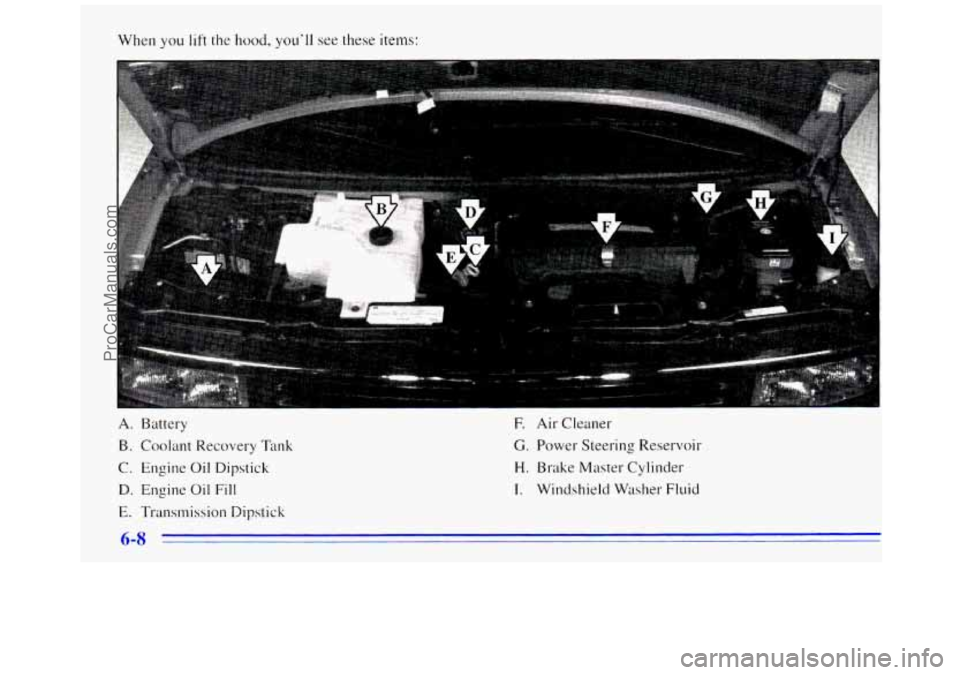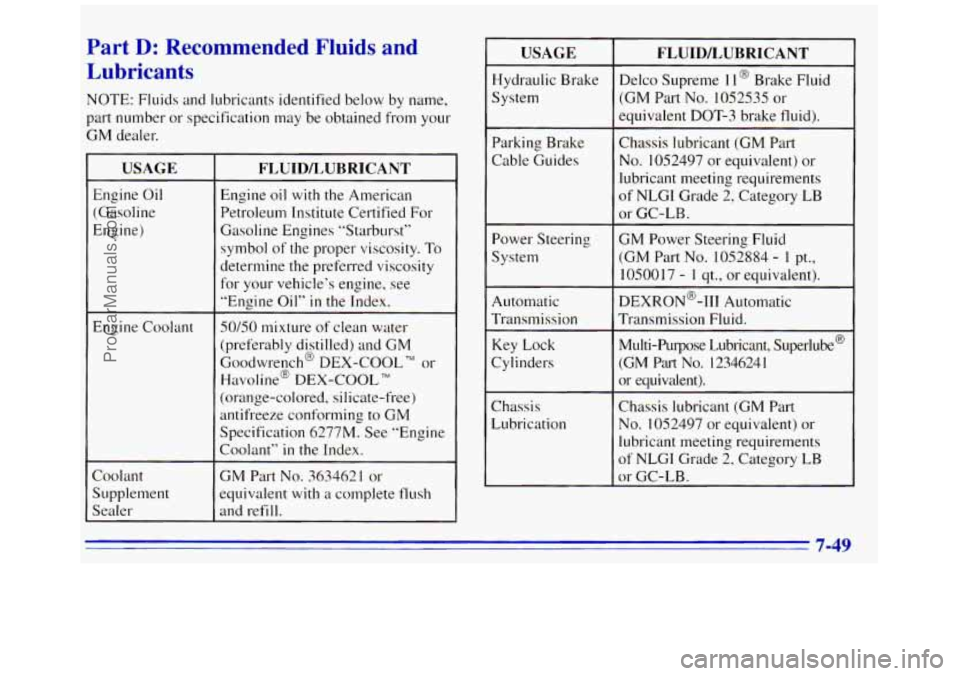1996 GMC SAVANA transmission oil
[x] Cancel search: transmission oilPage 184 of 372

Driving On Grades
Reduce speed and shift to a:lower gear before you start
down a long or steep doyngrade. If you don’t shift
down, you might have to use your brakes
so much that
they would get hot and no longer work well.
On a long uphill grade, shift down and reduce your
speed to around
45 mph (70 km/h) to reduce the
possibility
of engine and transmission overheating.
When towing at high altitude on steep uphill grades,
consider the following: Engine coolant will boil at a
lower temperature than
at normal altitudes. If you turn
your engine
off immediately after towing at high altitude
on steep uphill grades,
your vehicle may show signs
similar to engine overheating.
To avoid this, let the
engine run while parked (preferably on level ground)
with the automatic transmission in PARK
(P) for a few
minutes before turning the engine off.. If
you do get the
overheat warning, see “Engine Overheating” in the Index.
Parking on.Hills
You really should not park your vehicle, with a trailer
attached, .on a hill.
If something goes wrong, your rig
could start
to move. People can be injured, and both
your vehicle and the trailer can be damaged.
But if you ever have to park your rig on a hill, here’s
how to do it:
1. Apply your regular brakes, but don’t shift into
PARK
(P) yet. Then turn your wheels into the curb
if facing downhill or into traffic if facing ,uphill.
2. Have someone place chocks under the trailer wheels. I
3. When the wheel chocks are in place, release the
regular brakes until the chocks absorb the load.
4. Re-apply the regular brakes. Then apply your
parking brake and then shift to
PARK (P).
5. Release the regular brakes.
ProCarManuals.com
Page 185 of 372

When You Are Ready to Leave After
Parking
on a Hill
1. Apply your regular brakes and hold the pedal down
while you:
Start your engine:
Shift into a gear: and
Release the parking brake.
2. Let up on the brake pedal.
3. Drive slowly until the trailer is clear of the chocks.
4. Stop and have someone pick up and store the chocks.
Maintenance When Trailer Towing
Your vehicle will need service more often when you’re
pulling a trailer. See the Maintenance Schedule for more
on this. Things that are especially important
in trailer
operation are automatic transmission
fluid (don’t
overfill), engine oil, axle lubricant, belt, cooling system
and brake adjustment. Each
of these is covered in this
manual, and the Index will help
you find them quickly.
If you‘re trailering, it‘s a good idea to review these
sections before you start your trip.
Check periodically to see that
all hitch nuts and bolts
are tight.
Trailer Wiring Harness
The eight-wire harness, if you have one, is stored under
your vehicle along the rear frame crossmember.
It is
wrapped and bound with a plastic strap. The harness has
a 30-anlp battery feed and no connector, and you should
have a qualified electrical service person wire your
harness for you. Attach the harness
to the trailer, then
tape or strap
it to your vehicle’s frame rail. Be sure you
leave
it loose enough so the wiring doesn’t bend or
break, but not
so loose that it drags on the ground.
Store the harness
in its original place. Wrap the harness
together and tie
it neatly so it won’t be damaged.
The five-wire harness,
if you have one, is stored inside
the vehicle at the passenger side rear corner, behind the
jack. This should be wired by a qualified electrical
service person. It must be routed out
of your vehicle
between the rear door and the floor,
with enough of the
harness left on both sides
so that the trailer or the body
won’t pull
it.
Store the harness in its original place. Wrap the harness
together and tie
it neatly so it won’t be damaged.
4-37
ProCarManuals.com
Page 232 of 372

When you lift the hood, ~011’11 see these items:
A. Battery
B. Coolant Recovery Tank
C. Engine Oil Dipstick
D. Engine Oil Fill
E. Transmission Dipstick
F. Air Cleaner
G. Power Steering Reservoir
H. Brake Master Cylinder
I. Windshield Washer Fluid
ProCarManuals.com
Page 240 of 372

Automatic Transmission Fluid
7 ’ ~ n to Check and Change
A good time to check your automatic transmission fluid
level is when the engine oil is changed.
Change
both the fluid and filter every 50,000 miles
(83 000 km) if the vehicle’s GVWR is over 8,600 or
if
the vehicle is mainly driven under one or more of
these conditions:
0 In heavy city traffic where the outside temperature
0 In hilly or mountainous terrain.
0 When doing frequent trailer towing.
regularly
reaches
90°F (32°C) or higher.
0 Uses such as found in taxi, police or delivery service.
If your vehicle’s GVWR is not over 8,600 and you do
not use your vehicle under any of these conditions, the
fluid and filter do not require changing.
See “Scheduled Maintenance Services”
in the Index.
How to Check
Because this operation can be a little difficult, you
may choose to have this done at your GM dealer
Service Department.
If you do it yourself, be sure to follow all the
instructions here, or you could get
a false reading on
the dipstick.
NOTICE:
Too much or too little fluid can damage your
transmission.
Too much can mean that some of
the fluid could come out and fall on hot engine parts or exhaust system parts, starting a fire. Be
sure to get an accurate reading if you check your
transmission fluid.
ProCarManuals.com
Page 300 of 372

Maintenance Schedule
Short TripKity Definition -- Gasoline Engines i
Follow the Short Trip/City Maintenance Schedule if any
one of these conditions is true for your vehicle:
0
0
0
0
0
e
Most trips are less than 5 to 10 miles (8 to 16 km).
This is particularly important when outside
temperatures are below freezing.
Most trips include extensive idling (such as frequent
driving
in stop-and-go traffic j.
Most trips are through dusty areas.
You frequently tow
a trailer or use a carrier on top of
your vehicle.
You frequently tow
a trailer or us-e a carrier on top of
your vehicle. (With some models, you should never
tow
a trailer. See “Towing a Trailer” in the Index.)
If the vehicle is used for delivery service, police, taxi
or other commercial application.
Short Trip/City Intervals -- Gasoline Engines
Every 3,000 Miles (5 000 km): Engine Oil and Filter
Change (or
3 months, whichever occurs first). Chassis
Lubrication (or
3 months, whichever occurs first).
Drive Axle Service (or
3 months, whichever
occurs first).
At 6,000 Miles (10 000 km) -- Then Every
12,000 Miles (20
000 km): Tire Rotation.
Every 15,000 Miles (25 000 km): Air Cleaner Filter
Inspection,
if driving in dusty conditions. Shields and
Underhood Insulation Inspection (GVWR above
8,500 Ibs. only). Thermostatically Controlled Engine
Cooling Fan Check (or every
12 months, whichever
occurs first). Front Wheel Bearing Repack (or at each
brake relining, whichever occurs first).
Every 30,000 Miles (50 000 km): Air Cleaner Filter
Replacement. Fuel Filter Replacement.
Every 50,000 Miles (83 000 km): Automatic
Transmission Service (vehicles over
8600 GVWR
or driven under severe conditions only).
7-4
ProCarManuals.com
Page 302 of 372

Maintenance Schedule
Every 7,500 Miles (12 500 km): Engine Oil and Filter
Change (or every 12 months, whichever occurs first).
Chassis Lubrication (or every 12 months, whichever
occurs first). Drive Axle Service.
At 7,500 Miles (12 500 km) -- Then Every
15,000 Miles
(25 000 km): Tire Rotation.
Every 15,000 Miles (25 000 km): Shields and
Underhood Insulation Inspection (GVWR above
8,500 lbs. only). Thermostatically Controlled Engine
Cooling Fan Check
(or every 12 months, whichever
occurs first).
Every 30,000 Miles (50 000 km): Fuel Filter
Replacement. Air Cleaner Filter Replacement.
Front Wheel Bearing Repack (or at each brake
relining, whichever occurs first).
Every 50,000 Miles (83 000 km): Automatic
Transmission Service (vehicles over
8600 GVWR or
driven under severe conditions only).
Every 60,000 Miles (100 000 km): Engine Accessory
Drive Belt Inspection. Fuel
Tank, Cap and Lines
Inspection. Exhaust Gas Recirculation System
Inspection. Evaporative Control System Inspection.
Every 100,000 Miles (166 000 km): Cooling System
Service (or every
60 months, whichever occurs fist).
Spark Plug Wire Inspection. Spark
Plug Replacement.
Positive Crankcase Ventilation (PCV) Valve Inspection.
These intervals only sumnarize maintenance services.
Be sure to follow the complete maintenance schedule on
the.following pnges.
7-6
ProCarManuals.com
Page 313 of 372

I Short TripKity Maintenance Schedule -- Gasoline Engines I
48,000 Miles (80 000 km)
0 Change engine oil and filter (or every
3 months, whichever occurs first).
0 Lubricate chassis components; see
footnote
## (or every 3 months, whichever
occurs first).
as needed. ‘W
17 Check axle fluid level and add fluid
DATE
SERVICED BY ACTUAL MILEAGE
50,000 Miles (83 000 km)
0 Change automatic transmission fluid and
filter
if the vehicle’s GVWR is over
8600 lbs. or if the vehicle is mainly driven
under one or more of these conditions:
- In heavy city traffic where the outside
temperature regularly reaches
90°F
(32 O C) or higher.
- In hilly or mountainous terrain.
- When doing frequent trailer towing.
- Uses such as found in taxi, police or
delivery service.
7-17
ProCarManuals.com
Page 345 of 372

Part D: Recommended Fluids and
Lubricants
NOTE: Fluids and lubricants identified below by name,
part number or specification may be obtained from your
GM dealer.
USAGE
Engine Oil
(Gasoline
Engine)
Engine Coolant
Coolant
Supplement
Sealer
FLUID/LUBRICANT
~~ ~
~~
Engine oil with the American
Petroleum Institute Certified For
Gasoline Engines “Starburst“
symbol
of the proper viscosity. To
determine the preferred viscosity
for your vehicle’s engine, see
“Engine Oil”
in the Index.
50150 mixture of clean water
(preferably distilled) and GM
Goodwrench@ DEX-COOL
TM or
Havo line@
DEX-COOL TM
(orange-colored, silicate-free)
antifreeze conforming to GM
Specification 6277M. See “Engine
Coolant”
in the Index.
GM Part No. 3634621 or
equivalent with
a complete flush
and refill.
USAGE
Hydraulic Brake
System
Parking Brake
Cable Guides
~~
Power Steering
System
Automatic
Transmission
Key Lock
Cylinders
Chassis
Lubrication
FLUIDLUBRICANT
Delco Supreme 1 1 @ Brake Fluid
(GM Part No. 1052535 or
equivalent DOT-3 brake fluid).
Chassis lubricant (GM Part
No. 1052497 or equivalent) or
lubricant meeting requirements
of NLGI Grade 2, Category LB
or GC-LB.
GM Power Steering Fluid
(GM Part
No. 1052884 - 1 pt.,
1050017
- 1 qt., or equivalent).
DEXRON@-111 Automatic
Transmission
Fluid.
Multi-Purpose Lubricant, Superlube@
(GM
Pd-t No. 1234624 1
or equivalent).
Chassis lubricant
(GM Part
No. 1052497 or equivalent) or
lubricant meeting requirements
of NLGI Grade 2, Category
LB
or GC-LB.
7-49
ProCarManuals.com